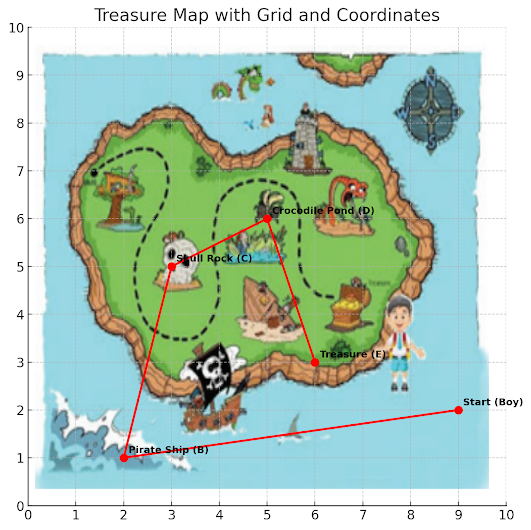Activity W 5.3 - Logic Clue Hunt on the Hundred Square
For this activity, students work in pairs or small groups.
The students may draw a hundred square as shown below:
Procedure
The following clues may be written on the blackboard:
The number is greater than 9.
The number is not a multiple of 10.
The number is a multiple of 8. ¾ The number is even.
The number is not a multiple of 11.
The number is less than 175.
Its ones digit is larger than its tens digit.
Its tens digit is odd.
Part A
Tell the students
How have a number in your mind that is on the hundred squares but you are not going to tell them what it is.
They have to ask you for any four clues out of the given eight clues.
With every clue they speak out, you will say just ‘YES’ or ‘NO’.
Try to find the set of four clues that help them to find the number in your mind.
Give a chance to each group to do this.
Strategy Tip: Encourage teams to choose clues that narrow the number range quickly.
Part B
Four of the given clues are true but they do not help in finding the number.
Find those numbers.
Reflection
Consider the questions that led the students being interested and able to progress, and those you needed to clarify.
Such reflection always helps you engage the students to find mathematics interesting and enjoyable.
If they do not understand and do something, they are less likely to become involved.
Part A: Which clues help identify the number?
We are given 8 clues. The goal is to identify one specific number using only 4 well-chosen clues. Here’s how you can think through the process:
Let's analyze each clue for usefulness:
Clue Analysis:
-
The number is greater than 9
➤ Too broad — eliminates only numbers 1–9.
Not very useful. -
The number is not a multiple of 10
➤ Removes numbers ending in 0 (e.g., 10, 20, ..., 200).
Somewhat useful. -
The number is a multiple of 8
➤ Strong clue. Narrows down to numbers like 8, 16, 24, 32, etc.
Very useful! -
The number is even
➤ All multiples of 8 are even already.
Redundant if Clue 3 is chosen. -
The number is not a multiple of 11
➤ Excludes numbers like 11, 22, 33, ..., 198.
Somewhat useful. -
The number is less than 175
➤ Trims the upper end.
Useful for narrowing down. -
Its ones digit is larger than its tens digit
➤ Powerful filter (e.g., 13, 24, 57, but not 31, 43).
Very useful! -
Its tens digit is odd
➤ Limits numbers to those with tens digit as 1, 3, 5, 7, or 9.
Very useful!
Example: Find the Hidden Number
Let's pick a number that satisfies the following 4 helpful clues:
-
Clue 3: Multiple of 8
-
Clue 6: Less than 175
-
Clue 7: Ones digit > Tens digit
-
Clue 8: Tens digit is odd
Let’s test numbers that are:
-
Multiples of 8
-
Less than 175
-
Have ones digit > tens digit
-
Tens digit is odd
Example: 136
-
Multiple of 8
-
Less than 175
-
Ones digit (6) > Tens digit (3)
-
Tens digit (3) is odd
→ 136 is a valid hidden number!
Part B: Which clues are always true but not useful?
These clues may be true for many numbers, but don’t help narrow the list:
-
Clue 1: Greater than 9 → Always true for almost all 2- or 3-digit numbers.
-
Clue 2: Not a multiple of 10 → Excludes just a few (10, 20, ..., 200).
-
Clue 4: Even → Already covered by “multiple of 8.”
-
Clue 5: Not a multiple of 11 → Useful only if the number was close to a multiple of 11.
So, the 4 clues that don’t help much, even if true, are:
-
Clue 1 (Greater than 9)
-
Clue 2 (Not a multiple of 10)
-
Clue 4 (Even)
-
Clue 5 (Not a multiple of 11)
These clues are logically true for many numbers but don’t help you zero in on the correct number efficiently.











